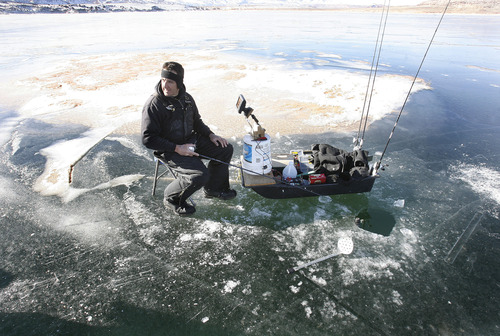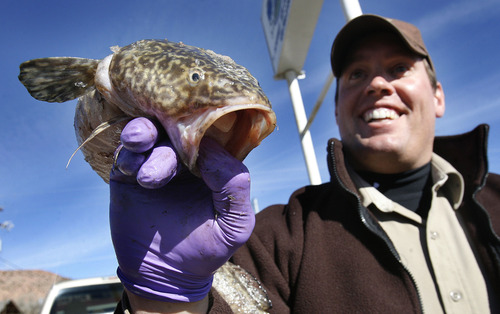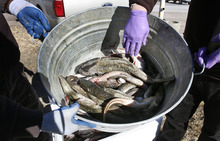This is an archived article that was published on sltrib.com in 2013, and information in the article may be outdated. It is provided only for personal research purposes and may not be reprinted.
While anglers hammer on one end of the invasive burbot population at Flaming Gorge Reservoir, researchers and biologists are studying other ways to keep the predatory fish from impacting popular sport fish at the massive lake.
About 1,100 anglers were expected at Flaming Gorge over the weekend to compete in the third annual Burbot Bash, enticed by a chance to win up to $10,000 for catching tagged fish and helping the popular fishery at the same time.
But not all the tagged fish were worth money. Some tagged burbot were valuable only to researchers.
Utah State University scientists, in a study funded by the Utah Division of Wildlife Resources (DWR) and in partnership with the Wyoming Fish and Game Department, implanted telemetry tags in 31 burbot caught in November. Researchers recently returned to see if the fish traveled and, if so, how far.
"This is a relatively recent invasion and we are still trying to figure out where they gather throughout the year," said Carl Saunders, a USU researcher in the College of Natural Resources' department of watershed sciences.
Saunders said the average size of their tagged fish is about 35 inches. The largest burbot involved in USU research at Flaming Gorge was just over 40 inches long and weighed 18 pounds.
Burbot, also known as a ling cod, are not native to the Green River drainage and are thought to have been illegally introduced in 2001. The eel-like fish are highly effective predators and are an unwelcome mouth at the Flaming Gorge table as they compete with existing popular sport fish like kokanee salmon, lake trout, smallmouth bass and rainbow trout.
Burbot not only compete directly with the sport fish by feasting on the same forage species, but also eat them outright.
Knowing where burbot congregate, specifically at the time of spawning, might allow for effective control measures. Anglers can target spawning areas when the fish numbers are high. (It appears to be occurring late December to early January.)
Biologists could visit spawning areas when the burbot fry are hatching and net them for removal from the reservoir or do spot fish-poisoning treatments.
But early indications from the tagged fish worry DWR Flaming Gorge Project Leader Ryan Mosley that it might be difficult to pinpoint locations where such efforts would be effective.
One of the longest movements between November and January included a roughly 40-mile journey during the spawn.
"Based on what we are seeing they are all over the place; going downlake and uplake. I'm not sure we could find a focus point," Mosley said. "It is amazing to me how much they are moving."
Funding for the research runs out in July, but the telemetry tags are designed to work for 12 to 18 months and getting another spawning season's worth of documentation is something Mosley would like to happen.
In the meantime, anglers will continue to do their share by catching and removing burbot from the Gorge. More than 6,500 burbot have been caught in the previous two Burbot Bash tournaments and with a record number of participants this year the number is sure to climb.
Mosley said the removal of those fish is beneficial to the reservoir, but probably only in a localized way.
And it is getting more difficult to encourage anglers to harvest burbot without attaching a possible $10,000 prize.
For years the two state agencies have been promoting burbot as a tasty fare for the table. They are indeed a mild-tasting fish from the cod family.
However, the Wyoming Department of Health recently issued a consumption advisory stating that women of child-bearing age and kids under 15 should not eat burbot longer than 30 inches and limit their intake to four meals a month due to mercury. Burbot on the Utah side of the reservoir have thus far tested under the consumption warning levels for mercury.
Utah has a mandatory catch and kill regulation on burbot and allows no limit on the fish. Wyoming is working to get burbot designated as a non-game species in the Green River drainage. The change would allow for a catch and kill regulation like in Utah.
Some wonder what the difference is between non-native burbot and the other fish in Flaming Gorge. All the sport fish in the reservoir — with the exception of non-native lake trout, which found their way down from the Wind River Mountains — were introduced by the states.
Mosley says there are economic reasons for protecting the existing sport fish populations in the Gorge.
"The decision to introduce the other species was based on the scientific knowledge of that time," he said. "Those species today draw a lot of anglers and provide a lot of recreational opportunities for people. It also brings in money to the communities around Flaming Gorge; money that people have come to rely on and burbot could impact that."







